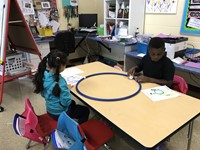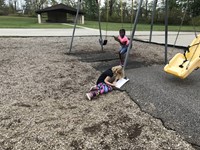Two Ohio teachers recently won Presidential Awards for Excellence in Mathematics and Science Teaching. The awards — the highest honors bestowed by the U.S. government specifically for K-12 mathematics and science (including computer science) teaching — were given to Wendy Teismann of Wilson Elementary School in Cincinnati’s Forest Hills School District, and to Vicki Willett of Licking Heights West Elementary School in Blacklick. The women, who were nominated for the awards and then submitted lengthy applications, were chosen for developing and implementing a high-quality instructional program that enhances student learning. Each received a certificate signed by the president, a trip to Washington, D.C., for recognition and professional development events and $10,000 from the National Science Foundation. More than 140 individuals and organizations were recognized for their teaching or mentoring at the recent PAEMST event. To find out what it takes to win this award, we contacted Vicki Willett (an interview with Wendy Teismann will be posted soon):
Q: Tell me about your educational background and your teaching experiences, and give us an overview of your current school and position.
 A: I have a bachelor of science degree from Florida State University in childhood education and am certified to teach K-8th grade. I earned my master’s degree in teacher leadership from National University.
A: I have a bachelor of science degree from Florida State University in childhood education and am certified to teach K-8th grade. I earned my master’s degree in teacher leadership from National University.
While in my master’s program, I was awarded National Board certification as an elementary generalist. The focus of the master’s was preparing the portfolio for the National Board for Professional Teaching Standards. I earned my Teacher Leader Endorsement from Ohio State University.
I currently teach first grade for Licking Heights West Elementary School in Blacklick, Ohio. This coming school year will be my 17th year. Prior to coming to Licking Heights, I taught preschool for Ourday in Westerville.
My school serves K-4 grade in a district that is bursting at the seams. When I started, there were six first grades. Now, there are 16. We have a fairly large refugee/immigrant population. This past year, in my class alone, I had children whose parents came from Ethiopia, Somalia, China, Nepal, Cameroon and Ghana.
Q: What prompted you to apply for the PAEMST, and what was involved in the application process?
A: Richard Wand, our school board president, nominated me for the award in 2012. I did not win, but I wanted to try again (I have a competitive streak), so I reapplied.
For the 2012 application, I was told I lacked state and national involvement. In 2014, I was invited to be a part of the Science Education Council of Ohio, so I thought this would be a plus when I reapplied for the PAEMST.
The application is fairly lengthy. I had to videotape myself teaching and then analyze that teaching. There are five dimensions:
- Mastery of the content appropriate for the grade level.
- Why it is important for students to learn.
- How it relates to more complex lessons and grades.
- Misconceptions.
- Use of instructional materials and strategies.
- Describe instructional approaches.
- Decision process in using the strategies.
- Modify to meet the needs of the learners.
- Effective use of assessments to monitor learning.
- What assessments did you use and how that improved your teaching.
- How you routinely assess …
- Your effectiveness on state and district measures.
- Reflective practices/lifelong learning.
- More successful and least successful part of the lesson.
- How I reflect on my teaching practice.
- Recent professional development.
- Leadership outside of the classroom.
- Support other teachers.
- Contribute to excellence in school, district, state or national level.
Q: In your application for the award, what do you think caught the eye of the judges?
A: I’m not really sure. I keep asking myself that.
The lesson that I videotaped for the application was part of problem-based learning unit. The students had applied to, and were hired by, a toy company to create a toy that went zigzag. Each day leading up to the culminating videotaped activity, I presented different inquiry-based investigations. Most were hands-on, but some were technology based. I used literature throughout the unit, including books about engineering and motion. The students referred to the books, on their own, throughout the lessons. Math was woven throughout with measuring and geometry.
The videotaped lesson showed the children playing with toys to discover different paths of motion that the toys would take. Some students extended the learning to determine how different-strength pushes and pulls changed the motion. Others investigated pushing versus pulling. The students drew diagrams and/or wrote in their engineering log books explaining their findings.
What might have caught the judge’s eye in the video was the fact that my students were engaged throughout. The lesson was developmentally appropriate. The students accurately spoke of their learning and took control of their inquiry. I also had a friend and my son check my science for accuracy.
|
|
|
Q: Tell us about your specific teaching strategies and any resources you use to sharpen your instructional approach.
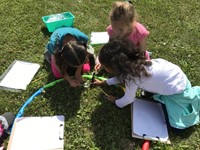
A: My teaching strategies involve inquiry and hands-on learning. I believe in active learning where the students are up and moving. I believe in letting them discover and decide. If the students are engaged, they are learning.
I am a lifelong learner. If there is a professional development opportunity, especially in the summer, I try to go. I want any and all ideas. I can’t try them all, but I do try some.
I love presenting because that forces me to focus on a topic and sharpen my skills. I also read and reread strategy books. Beside my computer I have six books that I am pulling information from to create a more student-centered math time.
Q: As a teacher, what have you learned from your students?
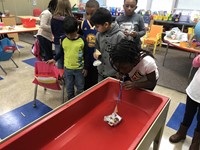
A: More than there is space here to write.
I have learned to be persistent. The following is a non-educational example, but it does speak to my kids’ influence on me: I was training to run the Columbus marathon. My training partner had gotten hurt, and I was going to quit. My son said, “Mom, would you let your kids quit learning to read when it got hard?” That was my inspiration — how hard my kids work. I completed the marathon.
I’ve also learned to let them learn from one another. I was doing a math lesson last year and had asked the students to visualize a ten frame. (We had worked a lot with ten frames, which are simple graphic tools that allow students to “see” numbers.) I asked the students to think of a ten frame for eight. “What do you see?” I asked. I was hoping for: “I see five on the top and three on the bottom.” That wasn’t the answer I got, but, oh, how much better of an answer it was: “I see two missing.” We were investigating the “make ten to add on” strategy. The student who answered understood that concept so much better than I did, and because she talked about it, the other students really listened.
Academically, this year I learned about torpor. I had never heard the term before. We were reading a book, and one of my students said, “But there is another state besides hibernation — torpor.” We looked it up, and she was right. Now my entire class, including me, knows about torpor.
Q: What keeps you engaged in teaching, and what have been the biggest challenges and greatest satisfactions you have experienced?
A: This one is easy — the kids keep me engaged, seeing their faces light up when they finally understand or figure something out.
Among the biggest challenges is the testing. Even in first grade, there are standardized tests. Children should not be identified as a score or a reading level. They are kids. Some take longer to understand something than others do, and that is OK. But boy, when they do understand, it is like they have hit a home run.
Q: Did you have a special teacher or mentor who inspired you? What is the best advice you have received as a teacher? What advice would you pass along to other teachers?
A: My teaching style is my modification of my girls’ chemistry teacher, Jeff Bracken. He focused on inquiry, and he inspired me.
However, my entire teaching team at Licking Heights inspires me every day. They are truly amazing and have wonderful ideas. We support one another.
A third source of inspiration are my three children and husband who love science. I did not. I hated it. They have encouraged and supported me throughout my journey to teach science.
One more person would be my friend and former teaching partner, Lin Maeder. She entered this crazy science journey with me, and we never looked back.
The best advice was not given to me but taken from a chemistry open house. At that event, Jeff explained to parents that he doesn’t teach chemistry like it is a cookbook. The students need to have the supplies necessary to solve the problem, but they must figure out the solution. That made me change how I taught science, to focus on inquiry. I have started doing more inquiry with math as well. Strategies are personal, so allowing students to discover what works best for them is important. Applying those strategies in different situations is crucial.
Other advice: Don’t be afraid to ask for help. Collaboration is fabulous. Don’t be afraid to try something new. If it doesn’t work, you learn from your mistakes.
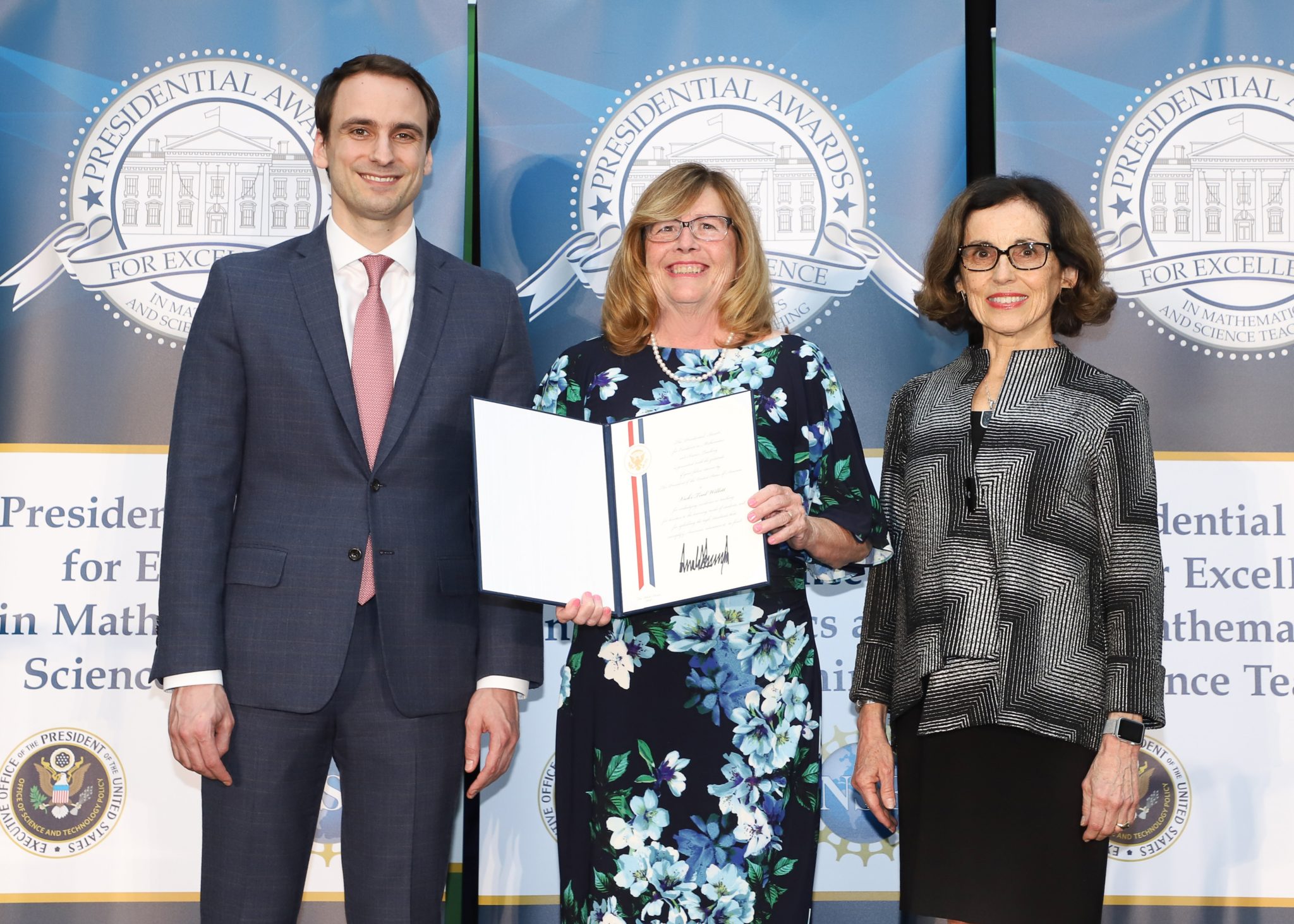
Q: Do you have a message for principals and administrators on how to support excellence in math and science teaching?
A: I teach first grade, and there is a strong emphasis on reading and math. For math, children need exposure using concrete manipulatives and ongoing professional development. People are frustrated with common core, but it is just that schools are teaching students differently than how we learned. Math-brained children and adults see numbers as patterns and strategies. We need the materials to let children discover number sense. My favorite quote is, “Number sense is caught, not taught.”
Science is a springboard to learning. Children are naturally inquisitive and naturally think of possibilities. I truly believe if we can engage them with science and inquiry, it is a springboard for them as they strive to read, write and do math. My students used different level books throughout the unit. I use interactive read alouds throughout science. Some of my kids learn to read and become better mathematicians because of science.
The following are true stories.
My class was doing an investigation of what a plant needs to grow. I paired the students, and that sparked their “wondering.” It worked out well because we had everything covered. One student and her partner wanted to compare a plant that was talked to with one that wasn’t. Every day, the girls would read to Princess Plantasia. Guess what? Their reading expression improved. They became better readers because of science.
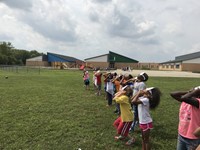
My second story is about a boy who struggled with math. He had trouble counting past 10 and recognizing two-digit numbers. My class was involved in a project with NASA’s GLOBE (Global Learning and Observations to Benefit the Environment) Program, taking surface temperatures. We would dutifully go out and take daily readings for the project. My little guy wanted to take the readings. He reported “3,” “2,” “4,” or whatever the numbers were. Before long, however, he started saying “32.4 degrees Celsius.” He learned his two-digit numbers because of science.
I would tell administrators to encourage teachers to teach real science and allow the students to investigate. Science is more than a read aloud or interactive writing. Both are important parts, but the inquiry is where students become engaged.
Teachers need support, professional development and the supplies to allow this to happen.
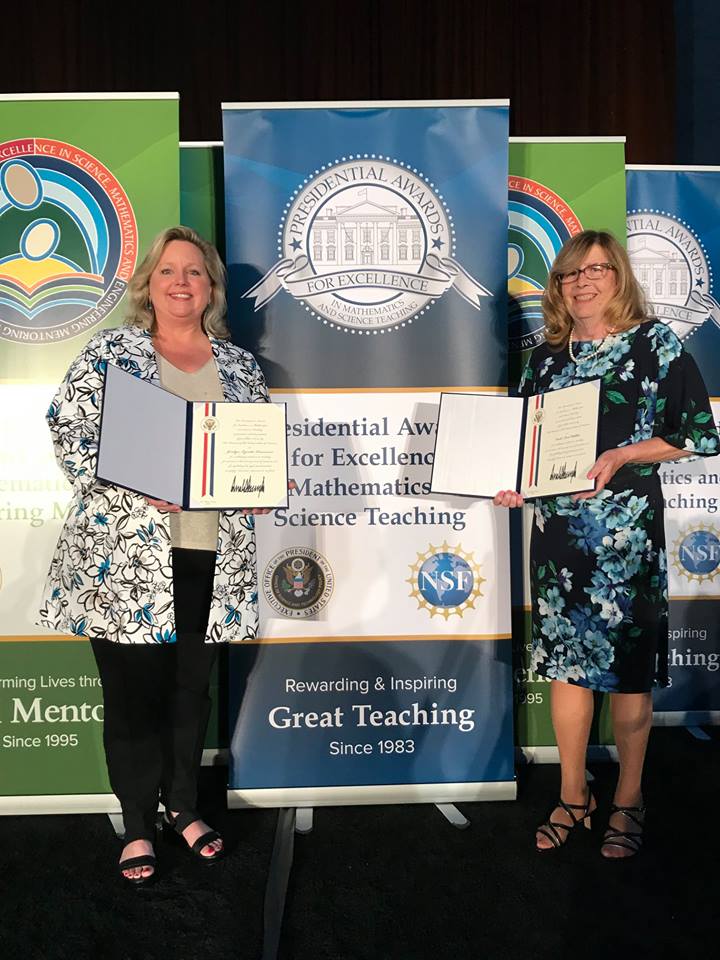
Q: What does winning the PAEMST mean to you?
A: This was a huge honor, and I am very humbled by the award. It is a validation for what I do, but I also see it as a validation of what all educators do. We didn’t go into teaching for the money or accolades, but it is nice to be noticed. I said in my bio that it was like winning the Heisman Trophy. It is the recognition for all the work we do every day.
Q: Finally, what will you do with the $10,000 award?
A: I plan to pay off my student loans. We have planted a garden at school, and I plan to repay myself for all of the expenses, including the plants, hoops and netting.
I also am hoping to purchase some technology to make a center in my classroom. I have purchased team shirts for my first grade team because without them, none of this would be possible. And, there are a few other people who were instrumental in all of this, and I would like to do something special for them as well.
